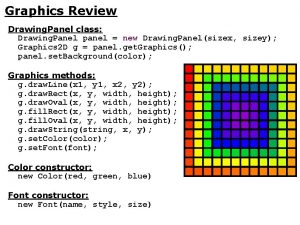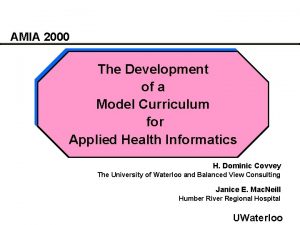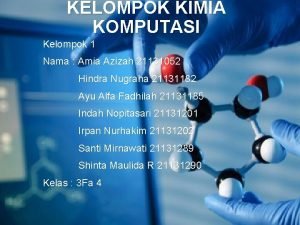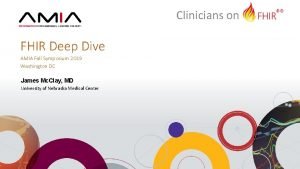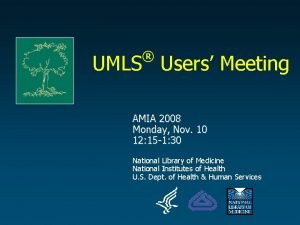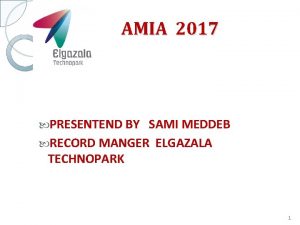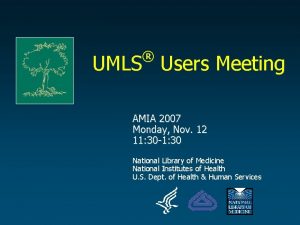Panel The AMIA 10 x 10 Program An





















- Slides: 21

Panel The AMIA 10 x 10 Program: An International Approach to Building Informatics Capacity The 10 x 10 in Spanish in Uruguay and Puerto Rico Alvaro Margolis, MD MS

Biomedical informatics training • University centered • Project centered

Conceptual model for training (Project-centric approach) Center of excellence Resources Skills sources Implementation project Selection Outcomes Evaluation Learn from success/failure Source: Global Partnership Program, AMIA. Match-making GPP Accreditation Contents development Advocacy


Example 1: Project in 23 health care institutions in Uruguay

• Target population: the Medical Director, the Heads of Information Systems, Medical Records, Administration and Nursing of each Institution. • Combination of on-site learning activities, site visits and online courses, both supported by local or regional academic institutions. • Integrated into the project needs and stages.

Online course on HL 7

10 x 10 course

Results • More than 100 professionals trained across the country – 10 x 10 course, 150 hours: 100 professionals, editions 2008, 2009 and 2010. – On-site introductory course: 85 professionals, editions 2008 and 2009. – HL 7 online: 40 information system professionals. – Informatics and nursing: 67 participants.

Train-the-Trainers Session: Introduction to the EHR

Weekly remote seminars

Application of the project-centric approach in Uruguay

References: Margolis A, Vero A, Bessonart L, Barbiel A, Ferla A. Health Information Systems Training for a Countrywide Implementation in Uruguay. Methods Inf Med. 2009; 2009 (1): 153 -157. Margolis A, Bessonart L, Barbiel A, Pazos P, Gil J, Machado H, Vero A. A countrywide clinical informatics project in Uruguay. Stud Health Technol Inform. 2010; 160(Pt 1): 391 -5.

Example 2: Certificate program in Health Informatics for Puerto Rico August – December 2012

Launching live session

Remote phase Portada del curso en el campus

Group interaction

Results Area Administration # % 12 30 Computer sciences 15 37. 5 Health sciences 10 25 3 7. 5 Communication and education Passed: 28 (70%)

Assessment by attendees • 71%: first distance education experience. • 82% considered the platform to be easy to use. • 65% considered that the overall course experience was excellent. • Time devoted to course per week: – 4 to 6 hours: 65%. – More than 6 hours: 35%.

Qualitative assessment • Positive aspects – – – – The structure of the course. The organization and contents. The tutoring by the course Faculty. That the language was Spanish. The flexibility (each attendee does the course at his/her own pace). Teamwork. The insight about different experiences in Latin America, USA and Europe. • Suggestions – To have two versions of the course: introductory and advanced. – To offer CME credits. – To have more synchronous remote sessions, and/or more scheduling options. – More team interaction in the remote workshops. – More adaptation to the local health care system.

Comments or questions? Alvaro. Margolis@evimed. net
 Ten ten program
Ten ten program Continuous panel vs discontinuous panel
Continuous panel vs discontinuous panel Zıt panel tekniği
Zıt panel tekniği Hình ảnh bộ gõ cơ thể búng tay
Hình ảnh bộ gõ cơ thể búng tay Bổ thể
Bổ thể Tỉ lệ cơ thể trẻ em
Tỉ lệ cơ thể trẻ em Chó sói
Chó sói Thang điểm glasgow
Thang điểm glasgow Hát lên người ơi
Hát lên người ơi Các môn thể thao bắt đầu bằng từ đua
Các môn thể thao bắt đầu bằng từ đua Thế nào là hệ số cao nhất
Thế nào là hệ số cao nhất Các châu lục và đại dương trên thế giới
Các châu lục và đại dương trên thế giới Công thức tính độ biến thiên đông lượng
Công thức tính độ biến thiên đông lượng Trời xanh đây là của chúng ta thể thơ
Trời xanh đây là của chúng ta thể thơ Mật thư tọa độ 5x5
Mật thư tọa độ 5x5 Phép trừ bù
Phép trừ bù độ dài liên kết
độ dài liên kết Các châu lục và đại dương trên thế giới
Các châu lục và đại dương trên thế giới Thể thơ truyền thống
Thể thơ truyền thống Quá trình desamine hóa có thể tạo ra
Quá trình desamine hóa có thể tạo ra Một số thể thơ truyền thống
Một số thể thơ truyền thống



























